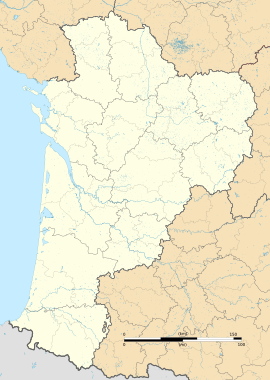Bédeille, Pyrénées-Atlantiques facts for kids
Quick facts for kids
Bédeille
|
|
|---|---|
| Country | France |
| Region | Nouvelle-Aquitaine |
| Department | Pyrénées-Atlantiques |
| Arrondissement | Pau |
| Canton | Pays de Morlaàs et du Montanérès |
| Intercommunality | Luy-Gabas-Souye et Lées |
| Area
1
|
3.85 km2 (1.49 sq mi) |
| Population
(Jan. 2019)
|
207 |
| • Density | 53.77/km2 (139.3/sq mi) |
| Time zone | UTC+01:00 (CET) |
| • Summer (DST) | UTC+02:00 (CEST) |
| INSEE/Postal code |
64103 /64460
|
| Elevation | 276–374 m (906–1,227 ft) (avg. 355 m or 1,165 ft) |
| 1 French Land Register data, which excludes lakes, ponds, glaciers > 1 km2 (0.386 sq mi or 247 acres) and river estuaries. | |
Bédeille is a small village in the southwestern part of France. It is located in the Pyrénées-Atlantiques département, which is like a county or region in France. Bédeille is known as a commune, which is the smallest type of local government area in France.
Contents
Exploring Bédeille
Bédeille is a quiet place with a small population. In January 2019, about 207 people lived there. The village covers an area of 3.85 square kilometers. This is roughly the size of 385 football fields!
Where is Bédeille?
Bédeille is part of the Pau arrondissement. An arrondissement is a larger administrative area in France. It also belongs to the canton of Pays de Morlaàs et du Montanérès. Cantons help organize local elections.
How High is Bédeille?
The village sits at an average height of 355 meters (about 1,165 feet) above sea level. The lowest point in Bédeille is 276 meters high. The highest point reaches 374 meters. This means the land has some gentle slopes.
Local Government
Like all communes in France, Bédeille has its own local government. This government helps manage the village's daily life.
The Mayor of Bédeille
The current mayor of Bédeille is Francis Sebat. He was elected for the term from 2020 to 2026. The mayor is like the leader of the village. They help make decisions and manage local services.
Working Together
Bédeille is also part of a group called Luy-Gabas-Souye et Lées. This is an "intercommunality" group. It means several communes work together on projects. They might share services like waste collection or public transport. This helps smaller villages get more done.
See also
 In Spanish: Bédeille (Pirineos Atlánticos) para niños
In Spanish: Bédeille (Pirineos Atlánticos) para niños



